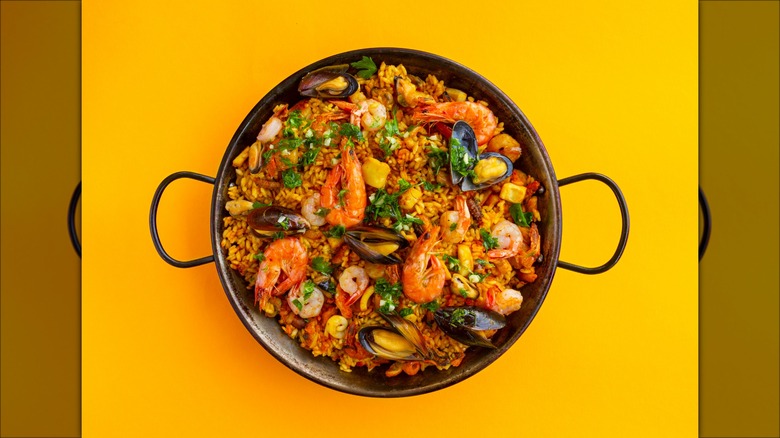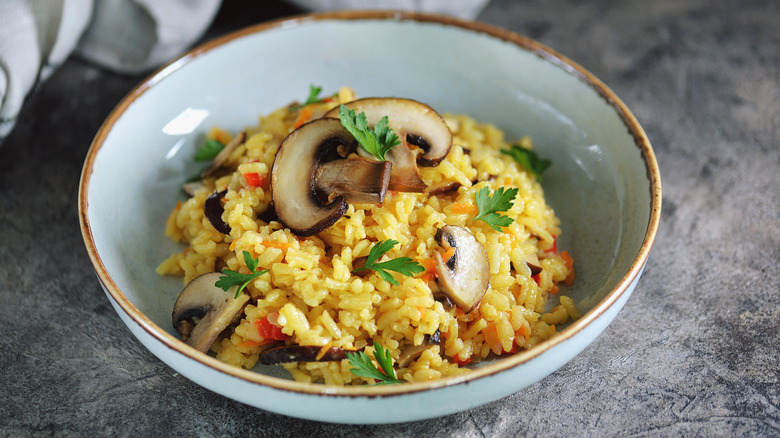Bobby Flay's Vegetarian Twist On Paella Leaves The Seafood Behind
Bobby Flay is best known as a media personality thanks to shows like "Beat Bobby Flay," but his comfort zone lies elsewhere. According to Flay's official website, the classically-trained chef considers the kitchen to be his safe haven "first and foremost." Yes, despite his fame, Flay remains dedicated to his culinary art and continues to enjoy concocting unique recipes with classical influences. Need an example? Look no further than Flay's distinctive, bold vegetarian take on everyday paella, once a staple at Flay's now-defunct restaurant GATO in New York City.
Prior to Flay shutting down GATO due to the COVID-19 pandemic, the NoHo establishment offered customers a varied assortment of entrees on the dinner menu, including this tweaked version of paella — a dish that cost $34 a plate. However, traditional paella served as the blueprint for Flay's veggie iteration. ("I'm always using classic flavor combos as a guide — they're classics for a reason," Flay said while discussing his take on paella in an interview with Bon Appétit.)
While the chef's paella features none of the hallmarks of traditional paella — among them chicken, rabbit, or duck, in addition to or instead of seafood, depending — that doesn't mean there's an absence of flavor. Indeed, it seems that Flay's paella breaks all the rules by kicking seafood to the stove-top curb, but what makes it still taste so delicious?
The deal with traditional paella
Before we delve into Bobby Flay's veggie paella, let's explore its progenitor: paella de marisco. According to Saveur, this traditional, saffron-spiced yellow rice dish dates back to 19th-century Spain, specifically to the coastal city of Valencia. Paella is named after the frying pan it was prepared in, known as a paellera, and rose in popularity with the development of the country's tourism trade.
As Saveur notes, there are elements of paella that are common despite possible regional variations — namely rice and a sofrito base that includes garlic, onion, ñoras (dried, red peppers), and tomatoes prepared in olive oil. Depending on the type of paella you're making (or eating), other ingredients might include a range of land-based proteins (among them chicken, duck, and rabbit) and/or more sea-oriented fare (such as shrimp, mussels, clams, and even lobster). And while vegetables do commonly make an appearance in these versions of paella, it's a little rarer to come across vegetarian-friendly paella fare. Luckily, Bobby Flay's spin on paella fills that need while kicking seafood and meat-based proteins right out of the frying pan.
Bobby Flay's mushroom paella with kale and eggs
You don't have to "Beat Bobby Flay" (or watch Flay's show) to enjoy the celebrity chef's veggie paella, despite GATO's coronavirus-related shuttering. Flay actually shared his mushroom paella with kale and eggs recipe with Bon Appétit, and they're ultimately three flavors that truly sing.
Two different kinds of mushrooms play a pivotal part in this particular paella dish. Per Bon Appétit, Flay uses 1 ounce of dried porcini mushrooms alongside 1 pound of "coarsely chopped" crimini mushrooms in the mushroom stock, which can be made up to four days ahead of time. As if that weren't enough 'shrooms, Flay uses another 1.5 pounds of "quartered" crimini while assembling the paella. After that, four large eggs join the party. Third, Flay incorporates a bunch of small, coarsely-chopped kale leaves (approximately 8 cups worth of them) — just remember to remove the ribs and stems.
A smorgasbord of other flavors helps round out Flay's veggie paella, including carrots, black peppercorns, garlic, poblano chiles, and dry white wine. Just keep in mind that, according to Flay himself, "the best part of any paella is the crisp layer of rice that forms on the bottom of the pan," so "make sure to scrape some out for each portion" (via Bon Appétit).


